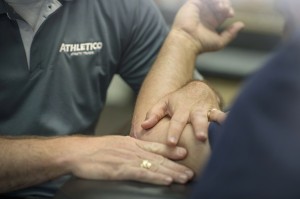
Occupational Therapy and the Treatment of Work Related Injuries
2 CommentsOccupational therapists treat a wide range of work related injuries in the clinic, both traumatic injuries and cumulative trauma disorders. Cumulative Trauma Disorders (CTDs) are the most common injuries seen by hand therapists for the Workers’ Compensation population.
These injuries include:
- Clinical syndromes such as tendon inflammations (tenosynovitis, epicondylitis, bursitis)
- Nerve compression disorders (cubital tunnel syndrome, carpal tunnel syndrome)
- Other sprains/ strains associated with the shoulder, elbow, wrist and hand
Upper extremity CTDs are most commonly the result of highly repetitive movements in conjunction with high grip/pinch forces and/or awkward postures with insufficient recovery time.
 Work injuries result in substantial costs to the employer in terms of lost time, medical expenses, and indemnity. There is also a significant impact on the quality of life for the injured worker. Highly skilled hand therapists work to make the patient feel better and get them back to work. Once back at work, Athletico Physical Therapy works to assist with long term health solutions and continued productivity for the injured worker.
Work injuries result in substantial costs to the employer in terms of lost time, medical expenses, and indemnity. There is also a significant impact on the quality of life for the injured worker. Highly skilled hand therapists work to make the patient feel better and get them back to work. Once back at work, Athletico Physical Therapy works to assist with long term health solutions and continued productivity for the injured worker.
The causes of the injury are addressed to see if any improvements can be made to the workstation, work methods, and/or tools used to complete the job. Athletico Physical Therapy On-Site Services are recommended for successful transition from injury to back to work. The various On-Site Services listed below provide the following value to all parties managing a case:
1) Identify the critical demands of the job tasks
2) Identify the risk factors for developing musculoskeletal injuries
3) Develop a spectrum of corrective solutions for the worker and employer for successful return to work.
Athletico Physical Therapy On-Site Services:
Job Analysis: Outlines the essential and marginal functions of the job, the physical demands of the job, and the frequency of any physical task performed. This includes:
- Lifting
- Carrying
- Push/Pull
- Reaching
- Grip and Pinch Forces
Ergonomic Analysis: Outlines how the workstation or work methods may contribute to musculoskeletal risk factors for injury while performing the essential and marginal job functions.
Return-to-Work Consultation: This is a service that is especially beneficial for those patients that have:
- sustained a traumatic injury, crush, amputation, de-gloving)
- had prolonged time off of work
- apprehensions about the performance of a difficult job task
- returned to the job task that resulted in the injury
A Return-to-Work Consultation is typically done with the occupational therapist, injured worker, and the supervisor at the job site. It is advisable to schedule this consultation on the first day back to work. The therapist is able to determine the employer’s concerns, observe the client perform the job, identify difficult tasks, and identify possible job modifications to the work method or work station.
Job Coaching: This is often a recommendation after the Return-to-Work Consultation. Job Coaching may be done with the injured worker in order to:
1) Learn a different work method
2) Work on a graded transition to full duty work
3) Improve productivity.
The occupational therapist acts as a “coach”, assisting the injured worker and the employer/supervisor with identifying alternative work methods, job rotation, or other tasks for the worker to perform. An example of a progressive transition back to full duty might include:
Week 1:
- Worker will perform full duty job tasks for 1 hour
- Perform restricted duty job tasks for an additional hour throughout the work shift
Week 2:
- Worker will perform full duty job tasks for 1 ½ hours
- Perform restricted duty job tasks for an additional hour throughout the work shift
- Each week, the goal is to have the client increase their time working full duty tasks, and reduce time doing restricted duty tasks.
Occupational therapists are highly skilled members of the team who treat the injured worker and specialize in the treatment of upper extremity injuries (shoulder to fingertip). The EEOC (maybe include full name for clarity) recognizes Occupational Therapists as qualified professionals to assess the relationship between an essential job functions and a worker’s ability to safely perform the job. The type of service recommended will be based on injury, job, and the clinical outcomes after therapy. There is considerable value when On-Site Services are considered prior to discharge. Proper services facilitate a successful return to work and decrease the risk for re-injury.
Athletico Physical Therapy offers a multitude of On-Site Industrial Services for the injured worker being treated for upper extremity injuries. Learn more about treatment of work related injuries by visiting here: http://www.athletico.com/services/work-comp/. Then request an appointment when you’re ready to get started!
Click to Request an Appointment Today
The Athletico blog is an educational resource written by Athletico employees. Athletico bloggers are licensed professionals who abide by the code of ethics outlined by their respective professional associations. The content published in blog posts represents the opinion of the individual author based on their expertise and experience. The content provided in this blog is for informational purposes only, does not constitute medical advice and should not be relied on for making personal health decisions.


2 Comments
Zequek Estrada
After reading this, I’m kind of grateful for
occupational therapists. I hadn’t realized how common work-related injuries are. It was pretty interesting to learn more about the what the services include.
Rachel
I’ve never heard of the process of how workers get treated to go back to work. It’s great that there are therapists out there that can help people get back on their feet and find ways to work around their injury. Thanks for sharing.